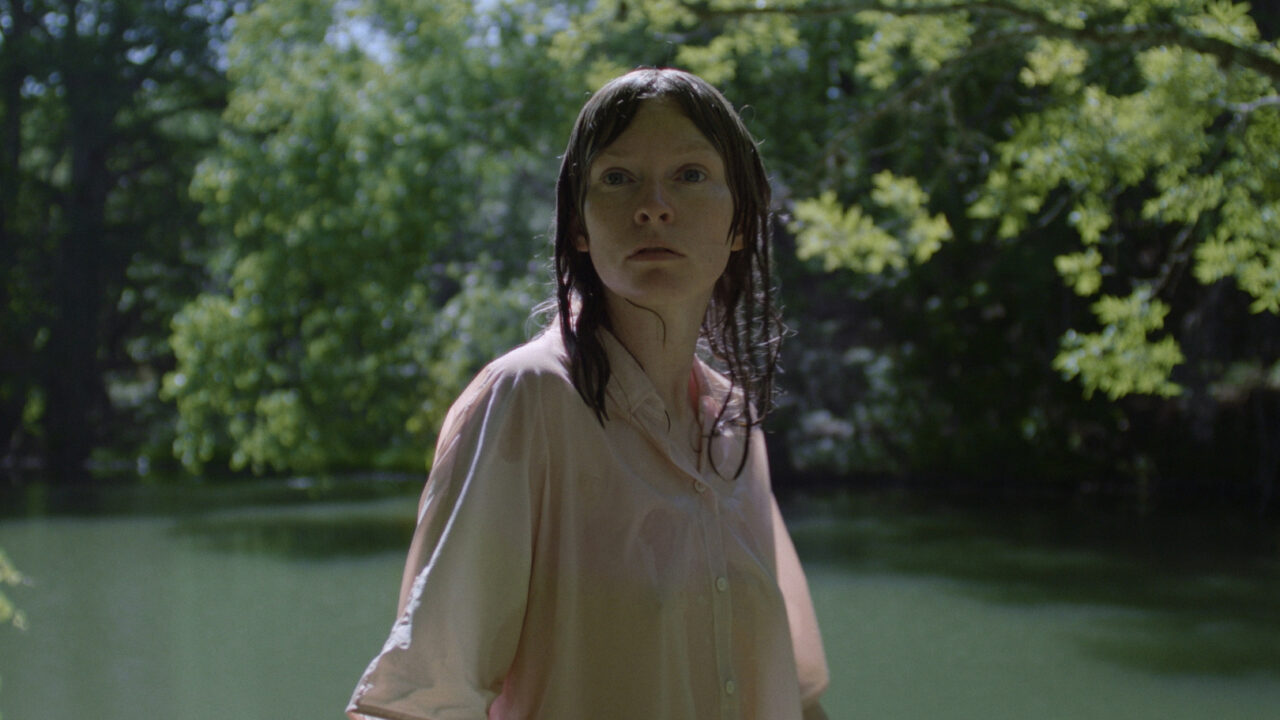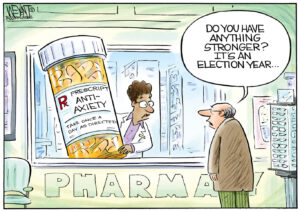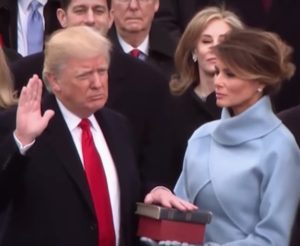Peering Into Memory
Lucy Kerr’s “Family Portrait” captures the unspoken dread of the early pandemic. Deragh Campbell in "Family Portrait." (Image: Insufficient Funds)
Deragh Campbell in "Family Portrait." (Image: Insufficient Funds)
In its infancy, the poet and physician Oliver Wendell Holmes dubbed the medium of photography “the mirror with a memory.” “Family Portrait,” the debut feature by Lucy Kerr, steps inside that mirror to explore its intimate emotional implications and its subtle psychological distortions. Set at the tail end of a family gathering as news of a mysterious respiratory illness begins to travel, protagonist Katy (Deragh Campbell) attempts to gather her sprawling family for a group photograph. The film’s withdrawn and minimalist imagery clashes violently, intentionally with its overbearing sound design, which frequently muffles dialogue and turns atmospheric noise into rumbling soundscapes. The result is a feeling of being extraordinarily unmoored amidst the ordinary, of experiencing unspoken, ominous anxieties that can only be named in retrospect.
One of the names we gave this feeling was COVID-19. But while the story is likely set in late 2019 or early 2020, “Family Portrait” isn’t solely about the recent pandemic. Rather, it’s about states of difficult transition, and about the elements of memory that define a person’s story. As Katy struggles to rope together her siblings, cousins and in-laws at their rural cabin, the mounting pressures of this self-imposed responsibility fracture her peace of mind. When it appears that her mother may have gone missing, Katy’s psyche gradually unravels. Campbell, though she maintains a tight grip on the character’s physical and emotional equilibrium, allows her grasp to slip on occasion, revealing suppressed frustrations, forced to the surface in brief but powerful bursts. Before long, her pleas to find her mother and finally click the family photo grow so frayed and desperate as to become disconnected from the casual setting. However, rather than Katy coming across as a woman gone mad, Kerr’s aesthetic lockstep with the character’s mindset makes it seem as though the world were coming slowly undone, in ways that don’t seem to concern anyone else — in ways only Katy can see.
This surreal depiction of events is likely how Katy would view the gathering in retrospect, but the casual conversations of the other guests paints a starkly different picture. To them, it’s just another day with the family. So, whose memory will the photograph more accurately reflect?
Whatever the answer, the version of events presented by Kerr unfolds as an eerie, atmospheric slow-burn surrounded by lush greenery. However, occasional scattered vignettes of each supporting character help weave a vivid family tapestry across three generations. During the film’s brisk 75 minutes, conversations about other pictures tend to fill the silences. Katy’s father (Robert Salas) tells of a famous photo of his own father being stretchered to safety during World War II, which was later retouched and used as an anti-war image during Vietnam. Other family members, and Katy’s visiting boyfriend Olek (Chris Galust), offer passing comments and compliments about old pictures in a family album, though the audience never sees these photographs. Instead, both the war photo, and the family’s bound collection of memories, become conversation pieces that quickly dovetail into other stories entirely, as if the images have now become a means of transition to tales and topics of conversation set in different decades, rather than windows into the specific moments they first captured.
And yet, Katy’s obsessive insistence on taking a family picture before she leaves — it starts to grate on her siblings — consumes the entire frame. The idea of the photograph, as both an heirloom and an idea, becomes paradoxically powerful and powerless, as the camera carefully searches the sprawling forest for the characters Kate tries to gather, who all become unwittingly duty-bound by this common familial ritual.
The movie premiered at the Locarno Film Festival, where Kerr was awarded the Boccalino D’Oro (or the Golden Jug) for Best Director by an independent jury of critics. It’s an accomplishment that speaks to the precision with which she frames even the emotionally imprecise — Katy is never quite sure what’s bothering her, or why — and the care with which she observes the often unobservable, like how even the most mundane and familiar family dynamics can begin to chip away at an already fragile person.
When Kate learns of the death of a step-cousin from a mysterious pneumonia, clicking the family photographs becomes a desperate act of memorializing. However, not everyone is privy to the news or its gruesome details, so when she becomes fixated on taking the photo, her understanding of what it represents is at a remove from that of most of her family. These sorts of misunderstandings inform the way Katy prioritizes the day’s itinerary, and the disruptive energy with which she navigates other people, who are usually caught up in their own carefree banter.
By making the viewer privy to each impetus behind Katy’s idiosyncrasies, the film injects each of her actions with distinct weight and reason. But by robbing her siblings of this insight, it adds a sting to their wordless dismissals, and their framing of her concerns as mere “quirks,” which become absorbed into the white noise that soon begins to surround her. The ensemble’s interplay — its detailed, lived-in depictions of family dynamics — is so lively that Katy’s subtle cries for help become lost amidst the boisterous chatter.
A deeply unsettling directorial debut, “Family Portrait” foregrounds lingering discomfort against a comfortable backdrop, and enhances its unspoken anxieties by poking and prodding at its protagonist.
The unnamed disease hasn’t yet caused a global shutdown in “Family Portrait,” but as a depiction of memory, the film seems to collapse moments and events together, forcing the viewer to untangle them and parse their meaning and timeline. Conversations constantly overlap, and the seasons aren’t entirely clear; it’s warm and sunny, even though this gathering would more likely have taken place during the winter months. Perhaps the film is a collection of memories untethered from time; perhaps Katy has confused details of this gathering with those of an earlier one, resulting in a dreamlike state when she wanders the forest in search of her mother. The time of day, or even how much time has passed between events, is seldom clear enough for the audience to grasp. Kerr has, instead, left us adrift.
Along with cinematographer Lidia Nikonova, Kerr brings a photographic eye to the film’s careful compositions, which scatter characters across the background and foreground of each shot, allowing the frame to buzz with life. However, even the camera is never quite certain of the larger story outside its confines. Within a given scene, it floats between family members in long, unbroken takes, scanning the frame as if it were zoomed in on a photograph in a true crime documentary, emphasizing individual characters rather than the bigger picture. But the moment it begins to pull out for the wider mise-en-scène, the movie cuts away. The context and order of events is obscured. Details are distorted. Faces are hidden behind tree branches or screen doors. Instead of traditional shot-reverse shot coverage of conversations, the camera creeps its way around characters’ faces and bodies during routine dialogue scenes, making them eerie in the process. Characters facing away from the camera, or refusing to engage in interpersonal conflict — i.e. actors refusing to perform the traditionally dramatic — becomes a primary source of drama.
This goes hand-in-hand with the content of their interactions too. When the family casually makes plans to meet up during Thanksgiving 2020, we know what’s likely in store for them, even if they do not. It’s possible that not all of them will live to see that holiday, a fact that makes the title melancholic: as a portrait of a family gathering, at a specific place and time, on the teetering edge of tragic developments.
A deeply unsettling directorial debut, “Family Portrait” foregrounds lingering discomfort against a comfortable backdrop, and enhances its unspoken anxieties by poking and prodding at its protagonist. Its most affecting images are those of Katy in isolation. Campbell — who also led the recent early-pandemic 3D experiment “A Woman Escapes” — is wildly adept at embodying the sense of listlessness that overwhelmed many of us in the first weeks of COVID shutdowns. She imbues Katy’s stillness with morose notes, a mood that Kerr synthesizes into something uncannily cinematic. The more the movie withholds, and the more it forces us to engage with the character’s despondency, the more psychological dimensions it reveals. The movie’s allure lies in its imagining of horrors and conflicts yet unseen, turning the very act of taking a photograph into the most important thing that Katy will ever do.
Your support matters…Independent journalism is under threat and overshadowed by heavily funded mainstream media.
You can help level the playing field. Become a member.
Your tax-deductible contribution keeps us digging beneath the headlines to give you thought-provoking, investigative reporting and analysis that unearths what's really happening- without compromise.
Give today to support our courageous, independent journalists.






You need to be a supporter to comment.
There are currently no responses to this article.
Be the first to respond.